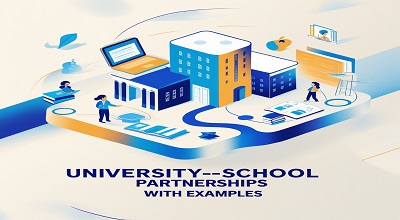University-School Partnerships
University-School Partnerships: In today’s rapidly evolving educational landscape, collaboration between universities and schools has become a cornerstone for improving teaching quality, enhancing student outcomes, and fostering innovation. The University-school partnership bridge the gap between academic research and practical classroom application, ensuring that both educators and students benefit from the latest pedagogical advancements.
This website post explores the latest trends, benefits, challenges, and real-world examples of university-school partnership. Whether you’re an educator, administrator, or policymaker, understanding these collaborations can help you implement effective strategies in your institution.
What Are University-School Partnerships?
Definition and Importance
University-school partnership (USPs) are collaborative initiatives where higher education institutions and K-12 schools work together to enhance educational outcomes. These partnerships focus on teacher training, curriculum development, research, and community engagement.
Key Objectives
- Improve teaching quality through professional development.
- Enhance student learning with research-backed strategies.
- Foster innovation in education through shared expertise.
Types of University-School Partnership
Teacher Training and Professional Development
Universities provide workshops, mentoring, and certification programs for school teachers.
Example: Harvard Graduate School of Education’s teacher training initiatives.
Curriculum Development and Enhancement
Collaborations to design and implement advanced curricula, including STEM and literacy programs.
Example: MIT’s partnership with K-12 schools for STEM education.
Research Collaborations
Schools serve as research sites for university-led educational studies.
Example: Stanford University’s research on student motivation in public schools.
Community Engagement Programs
Joint efforts to address local educational challenges through outreach programs.
Example: University of Toronto’s community tutoring initiatives.
Benefits of University-School Partnerships
1: For Schools
- Access to cutting-edge teaching methods.
- Improved student performance.
2: For Universities
- Real-world testing of educational theories.
- Enhanced teacher preparation programs.
3: For Students
- Exposure to advanced learning techniques.
- Better college readiness.
Challenges and Solutions
Common Barriers
- Lack of funding.
- Mismatched expectations.
Strategies for Success
- Clear communication and shared goals.
- Sustainable funding models.
Latest Examples of University-School Partnership
Global Case Studies
- Australia: University of Melbourne’s “Network of Schools” program.
- UK: University of Oxford’s teacher residency program.
Innovative Models
- Virtual mentorship programs.
- AI-driven personalized learning collaborations.
How to Establish Effective University-School Partnerships?
Step-by-Step Guide
- Identify mutual goals.
- Secure funding and resources.
- Develop a structured implementation plan.
Best Practices
- Regular evaluations.
- Stakeholder involvement.
Future Trends in University-School Collaborations
Technology-Driven Partnerships
- EdTech integrations.
- Virtual reality (VR) in teacher training.
Policy and Funding Developments
- Government incentives for partnerships.
- Corporate sponsorships.
Conclusion
University-school partnerships are transforming education by fostering collaboration between academia and K-12 institutions. By leveraging research, technology, and shared expertise, these partnerships enhance teaching quality and student success.
